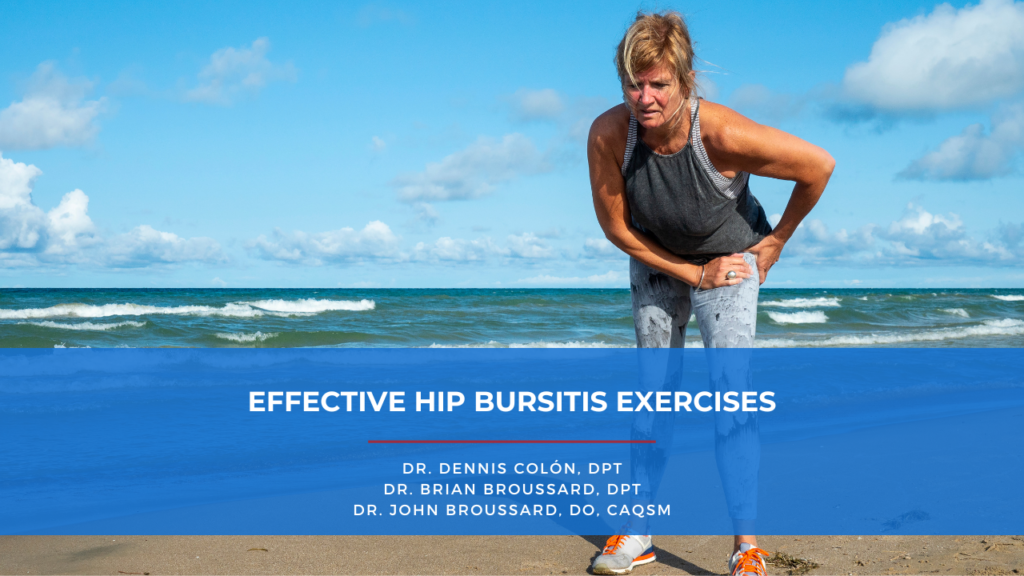Introduction
Hip bursitis is a condition that can significantly impact your quality of life. It can cause pain, stiffness, and reduced mobility. Understanding and managing hip bursitis is crucial whether you’re an athlete, someone with a physically demanding job, or simply seeking to maintain a healthy and active lifestyle.
This blog post aims to shed light on hip bursitis, exploring its causes, symptoms, and effects on daily activities. Moreover, it will guide you through effective hip bursitis exercises designed to relieve pain and enhance mobility.
What is Hip Bursitis?
Hip bursitis, or trochanteric bursitis, is a common source of hip pain. It occurs when the bursae, a small fluid-filled sac that cushions bones, tendons, and muscles near joints, become inflamed. This common condition can affect anyone but is more common among women and middle-aged or older individuals. Recognizing the signs, causes, and ways to prevent hip bursitis is essential for those seeking relief and returning to normal activity levels.
What are the effects of Hip Bursitis on daily activities?
Hip bursitis can significantly hinder daily activities, making simple tasks like walking, climbing stairs, or sitting for extended periods painful. It can lead to stiffness and reduced range of motion in the hip joint, affecting your ability to perform routine tasks and engage in physical activities, ultimately diminishing your quality of life.
What are the symptoms of Hip Bursitis?
The primary symptom of hip bursitis is pain at the point of the hip that often extends to the outside thigh area. Initially, the pain might be sharp and intense, evolving into a more constant ache as the condition persists. This discomfort can become particularly noticeable during activities such as squatting, leading to hip pain when squatting. Additionally, the hip may feel tender to the touch, and the pain could intensify at night, when lying on the affected hip, or when transitioning from a seated to a standing position.
What are the causes of Hip Bursitis?
This condition doesn’t arise without reason. It is often the culmination of various factors that put undue stress on the hip joints. Here’s a deeper look into the common causes:
- Repetitive Stress Activities: Engaging in activities that involve repetitive movements of the hip, such as running, cycling, or even standing for extended periods of time, can gradually wear down the bursae. This wear and tear primarily contributes to the inflammation known as bursitis.
- Direct Trauma: A direct blow or impact to the hip, which might occur during a fall, a sports injury, or an accident, can cause immediate swelling and inflammation of the hip bursa, leading to hip conditions like bursitis.
- Prolonged Pressure: Spending a lot of time sitting on hard surfaces or engaging in activities that put continuous pressure on the hips can irritate and cause inflamed bursa. This is why individuals with sedentary jobs or hobbies that involve prolonged sitting may experience hip bursitis.
- Previous Surgery or Hip Implants: Surgical procedures near the hip area or the presence of hip implants can alter the natural movements or pressures on the hip joint, potentially leading to bursitis. The body’s response to surgery or foreign objects (like implants) might include inflammation in nearby tissues, including the bursae.
- Underlying Health Conditions: Conditions that cause inflammation throughout the body, such as rheumatoid arthritis. This can also lead to inflammation of the bursae. These musculoskeletal conditions often worsen the likelihood of developing bursitis.
- Infections: Although less common, the bursae can become infected, especially in cases where there are open wounds near the hip. These infections can lead to an acute form of bursitis that may require immediate medical attention.
- Calcium Deposits: Over time, calcium deposits can form within the bursae or the surrounding soft tissues, leading to irritation and inflammation. These deposits can stiffen the area around the hip, making movements painful and contributing to the development of bursitis.
How can physical therapists help with Hip Bursitis?
Physical therapists play an important role in treating hip bursitis. A study indicates that nonoperative treatments such as physical therapy are effective and have helped most patients with hip bursitis. These professionals provide targeted hip bursitis exercises that strengthen the muscles around the hip to reduce pressure on the bursae.
Additionally, they may utilize manual therapy techniques to improve joint mobility and recommend activity modifications to prevent worsening the condition. By tailoring a specific hip bursitis treatment plan, physical therapists not only aim to achieve pain relief but also restore function.
Effective Exercises for Hip Bursitis

Incorporating specific exercises into your routine can significantly help relieve the symptoms of hip bursitis. These exercises aim to strengthen the muscles around your hip, enhance flexibility, and reduce the stress on the bursae. Here are some examples of exercises for hip bursitis that are designed to help you manage pain and improve mobility.
Glute Bridge
The Glute Bridge focuses on strengthening the gluteal muscles and stabilizing the pelvis, which can reduce pressure on the hip.
- Start Position: Lie on your back with your knees bent and feet flat on the ground, hip-width apart. Place your arms at your sides with palms down.
- Lifting: Exhale and lift your hips towards the ceiling by pressing your heels into the floor and squeezing your glute muscles. Your body should form a straight line from your shoulders to your knees.
- Hold: Hold the position for 5-10 seconds.
- Lowering: Slowly lower your hips back to the starting position.
- Repetition: Perform 10-15 repetitions, ensuring smooth, controlled movements throughout.
Side-lying Leg Lift
This exercise targets the hip abductor muscles, which are crucial for stabilizing the pelvis and reducing strain on the bursae.
- Start Position: Lie on your side with your legs straight and stacked on top of each other. Rest your head on your lower arm, and place your top hand on the floor for stability.
- Lifting: Slowly lift your top leg towards the ceiling while keeping your leg straight and your toes pointing forward.
- Hold: Hold the position for 2 seconds at the top.
- Lowering: Gently lower your leg back to the starting position.
- Repetition: Complete 10-15 repetitions on each side.
Clamshell
The Clamshell exercise strengthens the outer hip muscles, supporting hip joint stability.
- Start Position: Lie on your side with your hips and knees bent at a 45-degree angle. Rest your head on your lower arm.
- Opening: Keeping your feet together, raise your top knee as high as you can without rotating your hip or lifting your bottom knee off the floor.
- Hold: Pause at the top for a moment.
- Closing: Slowly return your knee to the starting position.
- Repetition: Perform 10-15 repetitions on each side.
Chair Squat
Chair Squats strengthen the quadriceps, glutes, and hamstrings, offering support to the hip joint.
- Start Position: Stand in front of a chair with your feet hip-width apart.
- Squatting: Bend your knees and lower your body towards the chair, as if you’re going to sit down. Keep your chest up and your back straight.
- Touching: Lightly touch the chair with your buttocks, but do not sit down completely.
- Rising: Press through your heels to return to the standing position.
- Repetition: Complete 10-15 squats, maintaining good form throughout.
Side Plank
The Side Plank exercise targets the obliques and core, supporting overall hip stability.
- Start Position: Lie on your side with your legs extended. Prop your body up on your lower elbow, aligning it directly under your shoulder.
- Lifting: Lift your hips off the ground, forming a straight line from your ankles to your shoulders.
- Hold: Hold this position for 15-30 seconds, keeping your core engaged and your hips lifted.
- Lowering: Slowly lower your hips back to the starting position.
- Repetition: Perform 2-3 repetitions on each side.
Iliotibial Band Stretch
Stretching the iliotibial (IT) band can help relieve tension and pain in the hip.
- Start Position: Stand near a wall for support. Cross your healthy leg in front of your affected leg.
- Stretching: Lean to the healthy side, pushing your affected hip outwards until you feel a stretch along the outside of your hip.
- Hold: Maintain the stretch for 20-30 seconds.
- Repetition: Repeat 2-3 times on each side.
Fire Hydrant
The Fire Hydrant exercise focuses on the hip abductors and rotators, enhancing hip strength and mobility.
- Start Position: Begin on all fours with your knees hip-width apart and your hands directly under your shoulders.
- Lifting: Keeping your knee bent, raise one leg out to the side as high as comfortably possible.
- Hold: Pause briefly at the top.
- Lowering: Gently lower your leg back to the starting position.
- Repetition: Perform 10-15 repetitions on each side.
Ease Hip Bursitis! Visit Alliance Regen & Rehab for Expert Exercises & Care

Finding the right guidance and care is important to recovery for those struggling with hip bursitis. At Alliance Regen & Rehab, you’ll discover a team of dedicated professionals with the knowledge and tools to help you overcome hip bursitis. Our tailored physical therapy exercises for bursitis of the hip focus on reducing bursitis pain, improving mobility, and preventing future injuries, ensuring you receive the most effective treatment option.
By opting for expert care, you benefit from a personalized exercise regimen that considers your specific condition, needs, and recovery goals. Alliance Regen & Rehab prides itself on utilizing the latest techniques and evidence-based practices to provide the highest quality care and treatments for hip bursitis.
Conclusion
Hip bursitis can be debilitating, but with the right approach, it doesn’t have to limit your life. Incorporating specific exercises into your daily routine can significantly relieve symptoms, improve hip health, and enhance your overall quality of life. Remember, consistency is key to seeing improvements, so make these bursitis hip exercises a regular part of your recovery plan.
FAQs
Is walking good for hip bursitis?
Walking can be beneficial for those with hip bursitis, especially when done correctly and in moderation. It’s important to start with short, gentle walks and gradually increase distance and intensity as your condition improves. However, if walking causes pain, it’s crucial to rest and consult with a health care provider for personalized advice.
What worsens hip bursitis?
Activities that involve repetitive hip movements or prolonged pressure on the hip, such as running, cycling, and sitting for extended periods, can worsen hip bursitis. It’s also important to avoid lying on the affected side and performing exercises that strain the hip area without proper guidance.
How long does hip bursitis last?
The duration of hip bursitis varies depending on the individual and the effectiveness of their treatment plan. With appropriate care, including rest, physical therapy, and targeted exercises, many people begin to see improvement within a few weeks. However, complete recovery can take several months, and ongoing management may be necessary to prevent recurrence.

